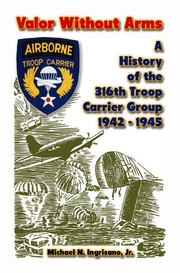
Valor without arms
By Michael N. Ingrisano
Subjects: World War, 1939-1945, United States, Aerial operations, American, United States. Army Air Forces. Troop Carrier Group, 316th, Regimental histories, American Aerial operations, History
Description: Merriam Press Military Monograph 13. Sixth Edition (February 2012). The 316th Troop Carrier Group was formed at Patterson Field, Ohio, in February 1942. By November, the Group air echelon consisting of Headquarters, 36th, 37th, 44th, and 45th Squadrons, flew to its first overseas post in Egypt. There, staff sergeant pilots flew their C-47s in support of the British 8th Army across North Africa from Egypt to Tunisia, delivering supplies and pioneering in air evacuation. The Group, less the 37th Squadron which remained in Egypt, dropped the 82nd Airborne Division in the invasion of Sicily as part of the operations HUSKY 1 and 2, on 9-11 July, 1943. In HUSKY 2, the 316th lost 12 out of the 23 troop carrier command aircraft that were shot down by friendly fire. In February 1944, the Group moved to Cottesmore, England, from where it participated in the invasions of France (Normandy, D-Day), Holland (MARKET GARDEN), and Germany (VARSITY). After 30 months of overseas duty, the 316th, one of the first troop carrier groups to be sent overseas, was one of the first to return to the United States in May 1945. Stationed at Pope Field, North Carolina, it trained with the 82nd for the pending invasion of Japan. That mission was aborted when Japan surrendered in August 1945. Group personnel wore nine battle stars, three Distinguished Unit Citations, Silver Stars, numerous Distinguished Flying Crosses, Air Medals, Purple Hearts, and Soldiers' Medals. Ingrisano, a radio operator, flew with the 37th Squadron from August 1943 to the end of the war. His history is based primarily upon official records. It is heavily footnoted, contains personal recollections from members of the Group, and a roster of some 2700 names. Students of the air war in World War II, especially of vertical deployment of troops, and genealogists will find this history to be an excellent source for future research. He is also the author of a pre- and post-Civil War history, An Artilleryman's War: Gus Dey and the 2nd United States Artillery.
Comments
You must log in to leave comments.